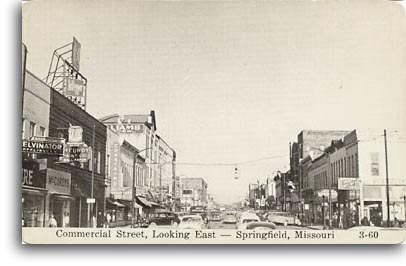HISTORICAL POSTCARDS OF SPRINGFIELD, MISSOURI
Commercial Street
 The Atlantic and Pacific Railroad, Springfield's first railroad, came to Springfield in 1870. It actually bypassed the town and laid its tracks a mile north of "old" Springfield into the "new" town of North Springfield. A commercial district sprang up around the railroad depot and the street was thus named "Commercial."
The Atlantic and Pacific Railroad, Springfield's first railroad, came to Springfield in 1870. It actually bypassed the town and laid its tracks a mile north of "old" Springfield into the "new" town of North Springfield. A commercial district sprang up around the railroad depot and the street was thus named "Commercial."
Commercial Street had a colorful reputation. Many Springfield businesses moved to North Springfield after 1870 to do business with the railroad. Bars, hotels and restaurants were opened to cater to rail personnel, inhabitants and travelers. It was the place to go for good food and music. It became a part of Springfield in 1887.
The date of the photograph in the postcard is approximately 1952. Commercial Street is still booming as you can see by the traffic and the many businesses, including McNier Furniture, McCurdy Paint Co. and Wallpaper, Chastains Department Store, Evan's Cut-Rite Drugs and Gammon Jewelry. This is near the end of the Commercial Street boom. In the early 1960s there was a population shift toward the south. This along with a decline in railroad travel caused north Springfield to deteriorate. Many of the hotels began to be populated by transients, and signs of urban blight set in.
By the early 1970s the Commercial Club, founded in 1928 as boosters of the Commercial Street area, had fueled interest in renewal and renovation of the historic street. It was designated a local historic district in 1978 and was placed on the National Register of Historic Places in 1983. Since then Commercial Street has become a center for soup kitchens and homeless shelters, such as The Kitchen, the Missouri Hotel and the Salvation Army. It has also become home to upscale loft apartments, antique shops, a beautiful display of sculpture, a farmer's market and the Frisco Days (formerly Railroad Days) festival.
Postcards Home | Keyword Search | Local History Home